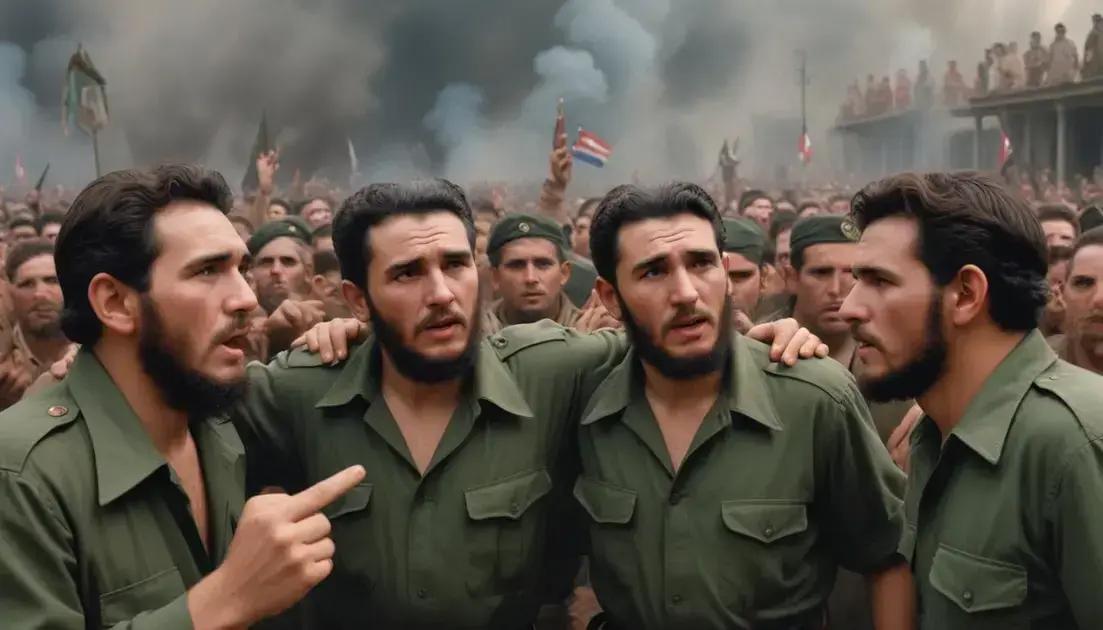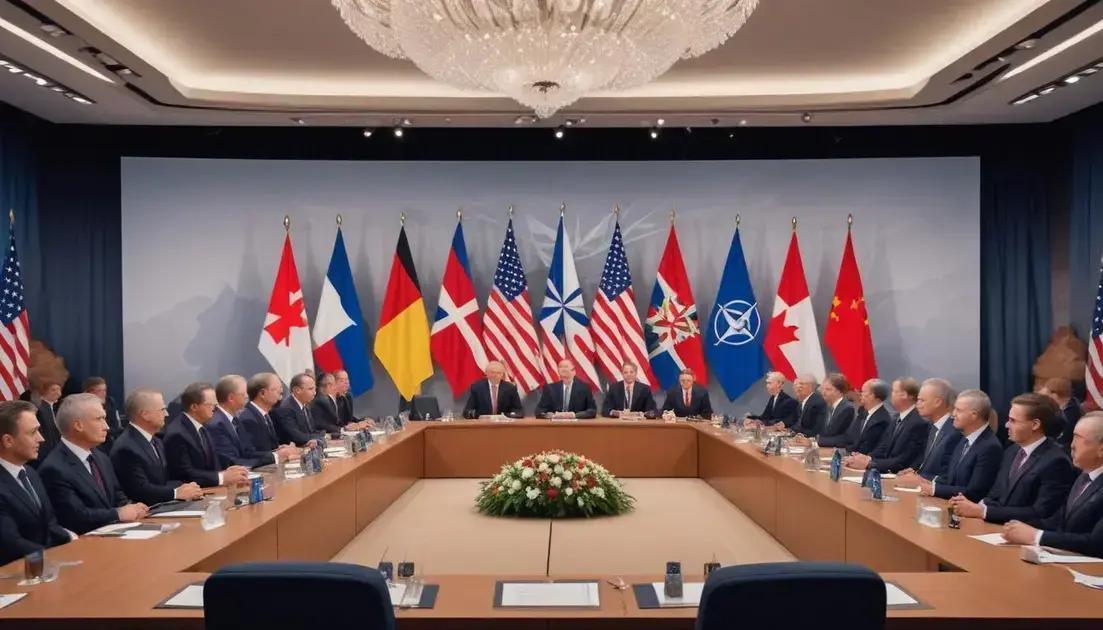
The Cuban Revolution: dreams, ideals, and consequences
The Cuban Revolution transformed Cuba’s political, economic, and social landscape, establishing a one-party system and implementing significant reforms. While it improved access to education and healthcare, it also raised human rights concerns. The revolution has inspired global movements and shaped Cuban identity, impacting both domestic and international perceptions of freedom and equality.
The Cuban Revolution is more than just a chapter in history; it’s a tale of dreams and ideals that sparked global conversations. What were the real outcomes, and how do they shape Cuba today?
The origins of the Cuban Revolution
The origins of the Cuban Revolution go back to the mid-20th century. At that time, many Cubans were unhappy with their government. The country faced issues like poverty, corruption, and inequality. People believed change was necessary and sought a new direction for their nation.
Growing Discontent
The discontent grew mainly due to the dictatorship of Fulgencio Batista. He ruled with an iron fist and did little to help everyday citizens. Many people felt oppressed and ignored.
Rise of Fidel Castro
Fidel Castro, a young lawyer, emerged as a leader of change. He formed a group called the July 26 Movement. Castro aimed to fight Batista’s regime and restore rights to the Cuban people. His passion inspired many to join his cause.
The Attack on Moncada Barracks
In July 1953, Castro and his followers attacked the Moncada Barracks. Although this attempt failed, it sparked a wider movement. Many saw Castro as a symbol of hope and resistance.
Support from the People
As the revolution progressed, more people supported Castro. Rural peasants and urban workers united under his leadership. They wanted an end to corruption and a better future.
By the end of the 1950s, the combination of widespread dissatisfaction and solid leadership made revolution inevitable. Castro’s movement was gaining momentum, setting the stage for a significant change in Cuba’s history.
Key figures in the Cuban Revolution
Several key figures in the Cuban Revolution played major roles in shaping the course of Cuba’s history. These individuals helped fight against oppression and pushed for a new government.
Fidel Castro
Fidel Castro is perhaps the most famous revolutionary leader. He became the face of the revolution. Castro’s determination and charisma caught the attention of many. He rallied support and inspired a nation.
Che Guevara
Che Guevara was another essential figure. An Argentine doctor, he shared Castro’s vision for a new Cuba. Guevara was known for his tough stance and strategic mind. He played a big part in military tactics during the revolution.
Camilo Cienfuegos
Camilo Cienfuegos was also crucial to the revolution. He was known for his bravery and loyalty to Castro. His leadership during battles helped the movement gain ground. Cienfuegos inspired many with his passion and commitment.
Raúl Castro
Raúl Castro, Fidel’s brother, played a big role as well. He took part in the initial attacks and helped organize rebel forces. After the revolution, he held many high positions in the government.
Supporters and Allies
Many other supporters, both men and women, took part in the revolution. Their determination to fight for change made a real difference. From students to farmers, people united for a common cause. This mix of talented leaders and passionate followers fueled the revolution.
Major events during the revolution
Several major events during the revolution played key roles in changing Cuba’s future. These events were crucial for the success of the revolution.
Attack on Moncada Barracks
The Attack on Moncada Barracks happened on July 26, 1953. This was one of the first major confrontations against Batista’s regime. Although it ended in failure, it inspired many to join the revolution.
Guerrilla Warfare
After Moncada, Castro and his followers went to the Sierra Maestra mountains. They used guerrilla warfare tactics. This method helped them win battles against a stronger military. Small, surprise attacks confused Batista’s forces.
The Granma Expedition
In December 1956, Castro and others returned from exile on the Granma yacht. This journey marked the start of their fight. They landed on Cuba’s coast and began building support for their cause.
The Capture of Havana
By December 1958, the revolution gained a lot of momentum. Rebel forces advanced towards Havana, the capital. The attack on the city became a major turning point. Batista’s forces were overwhelmed and struggled to fight back.
Batista’s Flight
On January 1, 1959, Batista fled Cuba. This event marked the end of his dictatorship. Castro and his forces entered Havana triumphantly, taking control of the country. It was a moment of celebration for many Cubans.
Implementation of Reforms
After the revolution, Castro’s government began to implement major reforms. These included land reforms and education improvements. The goal was to create a more equitable society.
Impact of the Cuban Revolution
The impact of the Cuban Revolution was felt far beyond its borders. It changed Cuba deeply and influenced other nations.
Social Reforms
One major impact was the implementation of social reforms. The government focused on education and healthcare. Schools were built, and medical services became accessible for all.
Economic Changes
The revolution also changed Cuba’s economy. Castro’s government nationalized many industries, including sugar and tobacco. This shift aimed to distribute wealth more equally. However, it faced challenges, especially from the U.S. trade embargo.
Political Landscape
Politically, the revolution led to a one-party system. Freedom of speech and assembly were limited. Many Cubans opposed the regime and faced persecution.
Global Influence
Internationally, the Cuban Revolution inspired leftist movements worldwide. It became a symbol of resistance against imperialism. Many saw it as a fight for rights and freedoms.
Cuban Exile Communities
The revolution also resulted in large Cuban exile communities. Many people fled to the U.S. and other countries. These exiles continue to influence politics and culture.
Long-lasting Legacy
Today, Cuba’s history and ideology still generate debate. The revolution reshaped Cuban identity and sparked discussions about freedom and equality.
Legacy and consequences of the revolution
The legacy and consequences of the revolution continue to shape Cuba today. The effects are visible in many aspects of Cuban life.
Political Legacy
The revolution established a one-party system that endures. Political dissent is often met with strong resistance. This has led to debates about freedom and democracy.
Economic Consequences
Cuba’s economy transformed after the revolution. Many industries were nationalized. The economy faced challenges, especially after the U.S. trade embargo. This has made it hard for many Cubans to access resources.
Social Changes
Socially, the revolution improved education and healthcare. These services became accessible to everyone, not just the wealthy. Many people enjoyed basic needs that were previously out of reach.
Human Rights Concerns
However, human rights issues also emerged. Critics argue that the government restricts freedoms. Activists have faced punishment for speaking out.
Cuban Identity
The revolution also shaped Cuban identity. It instilled a sense of pride and resistance. Many Cubans view it as a symbol of strength against oppression.
Influence on Other Countries
Globally, the Cuban Revolution influenced many movements. It served as an inspiration for leftist groups around the world. Leaders often referenced Castro’s struggle as they fought against imperialism.
Conclusion
In conclusion, the Cuban Revolution significantly changed Cuba and left a lasting mark on the world. Its impact on politics, society, and culture continues to resonate today. While it brought improvements, like access to education and healthcare, it also raised human rights concerns.
The legacy of the revolution instills pride for many Cubans. They see it as a fight against oppression and a symbol of strength. Yet, it also serves as a reminder of the ongoing struggles for freedom and equality.
Understanding the complexities of this history is vital. It helps us appreciate the achievements and challenges that Cuba faces now. The story of the Cuban Revolution is not just about the past; it shapes the future of its people.


